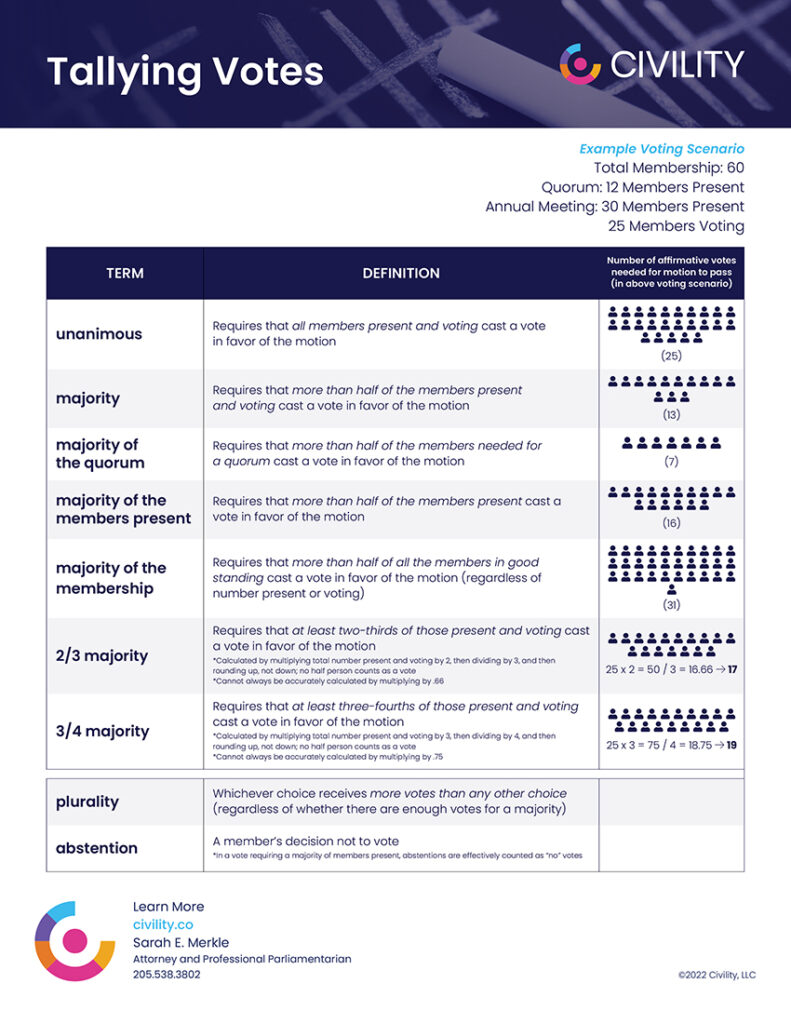For many of us, “doing math under pressure” falls into the “avoid-at-all-costs” category of potential life experiences. So, when it comes to calculating the results of a vote during a meeting, we feel a little anxious. Today’s post gives you a roadmap for that process with the hope of calming your nerves a bit.
First, if you’re thinking that you won’t ever be the one asked to calculate and announce the results of a vote, please don’t check out just yet. Even if you’re not calculating results in an official capacity, having the skill to do so accurately and quickly is key to evaluating the voting power in a room and crafting the strategy necessary to win controversial votes.
Also, if you’re asked to calculate a vote under pressure, start by taking a breath and reminding yourself that adding one or two extra minutes to the process to ensure it’s done correctly likely will not make any meaningful difference to the individuals waiting for the results. It’s always better to take the time needed to calculate votes correctly the first time than to have to make a correction later.
Now, here are the steps to follow in calculating a vote.
Step 1: Determine the baseline number from which you will calculate the vote.
The first step in calculating a vote is to determine the baseline number of people from which the required number of votes will be calculated. You might assume that the baseline number will always be the number of people who voted. But there are actually several options, and looking at your governing documents and parliamentary authority is the best way to determine which option applies.
Here are some possibilities: your bylaws may say to calculate your vote based on the total number of…
- the entire membership
- the members present
- the quorum
- the members present and voting
So, start by figuring out which option your organization has selected as the baseline number for vote calculations. This number will become the numerator in your calculation.
Step 2: Determine the required vote threshold.
Check your governing documents or parliamentary authority to determine how many “yes” or “in favor” votes are needed for that motion to be adopted or for that person to be elected. Typically, this “vote threshold” will be either a majority, or two-thirds, or three-fourths.
This number will become the denominator in your calculation.
- If your vote threshold is called a majority, use “2” as the denominator.
- If your vote threshold is “2/3,” use 2/3 as the denominator.
- If your vote threshold is “3/4,” use 3/4 as the denominator.
Step 3: Divide the baseline number by the required vote threshold, and round up to the nearest whole number.
Deep breath. We’re simply going to use the numbers from steps 1 and 2 to calculate the number of votes needed. (And yes, you can use the calculator on your phone or computer to make sure you’re doing it right! There’s no need to tax your brain extra with pencil and paper.)
Here’s the formula: the baseline number (from step 1), divided by the vote threshold (from step 2), with the result then rounded up to the nearest whole number—no decimal points, tenths, or hundredths allowed.
Extra Notes
- A majority means “more than half”—not 51%.
- Two-thirds is not always the same as 66.66%.
- There are no “half people,” so if the result of a calculation is not a whole number, then you should round up to the nearest whole number.
- In calculating a majority, after you divide by 2, if the result is a whole number, add one more person/vote to calculate “more than half.”
- Dividing by a fraction adds a step to the calculations. If your vote threshold denominator is 2/3 or 3/4, you need to first multiply, then divide.
- For a vote threshold of 2/3, multiply the baseline number by 2, then divide by 3.
- For a vote threshold of 3/4, multiply the baseline number by 3, then divide by 4.
Those final details just described are critical for calculating votes properly. But…. Once you’ve followed all three steps above and applied all of the extra notes, the answer to this calculation = your magic number—the number of votes needed for the motion to pass or for a person to be elected.
Example Vote Calculations
Example 1
An organization has 60 total members. At the meeting, 30 members are present, and 25 members vote.
- Step 1: The bylaws state that vote calculation should be based on the members present. In this case, the number present is 30.
- Step 2: The bylaws also state that the required vote threshold is a majority of the members present, so the vote threshold is 2.
- Step 3: 30 divided by 2 = 15.
- Since majority means “more than half,” 16 votes are needed for a motion to be adopted or for a person to be elected.
Example 2
An organization has 60 total members. At the meeting, 30 members are present, and 25 members vote.
- Step 1: The bylaws state that vote calculation should be based on the members present and voting. In this case, the number present and voting is 25.
- Step 2: The bylaws also state that the required vote threshold is 2/3 of the members present and voting, so the vote threshold is 2/3.
- Step 3: 25 multiplied by 2, divided by 3 = 16.66.
- Since the vote calculation must be rounded up to the nearest whole number, 17 votes are needed for a motion to be adopted or for a person to be elected.
I’ll close by referring all you visual learners to Civility’s new resources page—where two helpful infographics are available as printable PDF downloads: a list of voting terms with definitions, and a guide to tallying votes. Check them out for more help.
Where to Learn More


